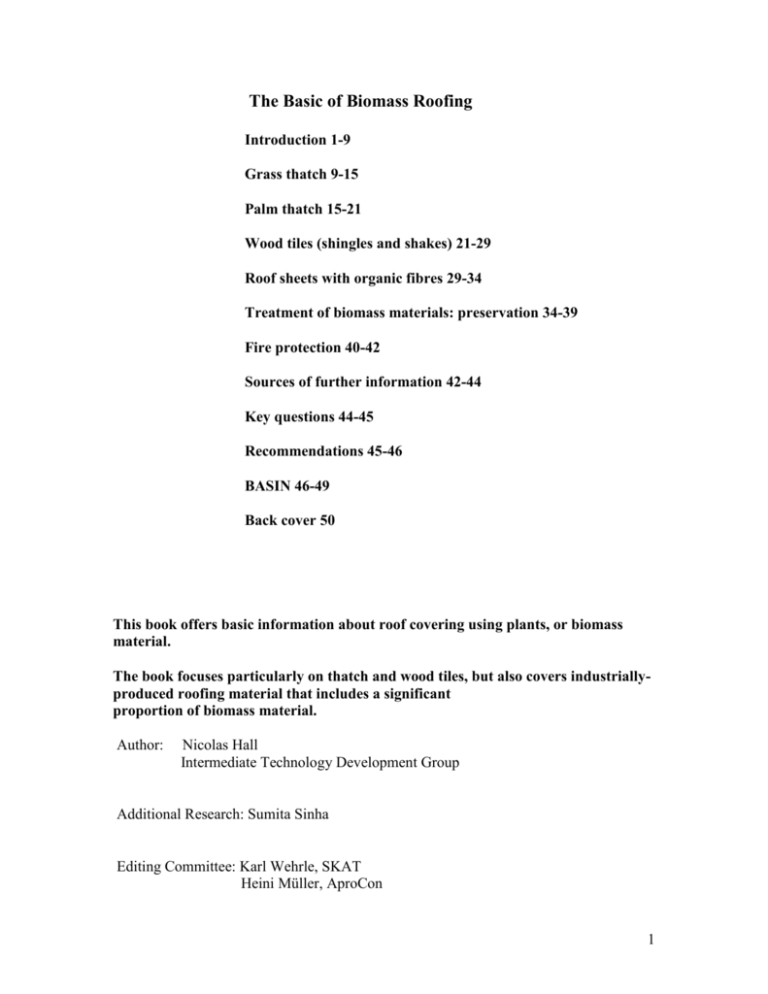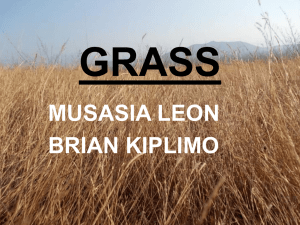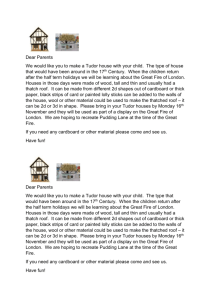The Basic of Biomass Roofing
advertisement

The Basic of Biomass Roofing Introduction 1-9 Grass thatch 9-15 Palm thatch 15-21 Wood tiles (shingles and shakes) 21-29 Roof sheets with organic fibres 29-34 Treatment of biomass materials: preservation 34-39 Fire protection 40-42 Sources of further information 42-44 Key questions 44-45 Recommendations 45-46 BASIN 46-49 Back cover 50 This book offers basic information about roof covering using plants, or biomass material. The book focuses particularly on thatch and wood tiles, but also covers industriallyproduced roofing material that includes a significant proportion of biomass material. Author: Nicolas Hall Intermediate Technology Development Group Additional Research: Sumita Sinha Editing Committee: Karl Wehrle, SKAT Heini Müller, AproCon 1 Daniel Schwitter, SKAT Illustrations: Matthew Whitton First edition: 1997 by SKAT Publisher: Swiss Centre for Development Cooperation in Technology and Management (SKAT) CH-9000 St. Gallen, Switzerland Distributor: Intermediate Technology Publications (it), 103-105 Southampton Row London WC1B 4HH, England E-mail: itpubs@gn.apc.org Fax: +44 171 436 2013 ISBN: 3-908001-73-0 Introduction Fundamental information This books offers basic information about roofcovering using plants, or biomass material. The book focuses particularly on thatch and wood tiles, but also covers industriallyproduced roofing material that include a significant proportion of biomass material. In this book you will find information about the advantages and disadvantages of specific materials and techniques, basic information about materials, skills, performance and cost. There are addresses and literature lists for further information and to obtain more detailed technical information. A time-honoured technology 2 Historically, people in almost every part of the world have depended on local materials for building. And for the most exposed element - the roof - plants were usually the only local resource that could be turned into a durable and weathertight covering. The result is a rich heritage of roofing technique and architectural technology. Today, a rudimentary thatch remains the only option for poor rural communities in most developing countries. In contrast, many wealthy people in Europe choose to live under a meticulously manicured reed thatch or perhaps, in N. America, a roof of timber shingles. Shingles are an attractive modern roofing material Reed thatch such as in England lasts more than 60 years Revaluing the vernacular The vast array of very different ways to use plants for roofing reflects the diversity of need, culture, economy and environment. Simple methods use unprocessed dried leaves tied to a rough roof frame. Such a thatch may only last a year. Others rely on careful cultivation of selected species and highly skilled craftsmanship or complicated industrial processes and are as durable as stone, concrete or fired clay tiles. Although many traditional techniques are being abandoned as resources become scarce and as attitudes and aspirations change, others are still being refined and new techniques are constantly being developed. Increasing awareness of the urgent need to ration global consumption of non-renewable resources is placing greater emphasis on renewable materials. 3 In the Philippines the skill of creating a watertight roof from split bamboos is in declining demand. Bamboo is not so plentiful and many prefer a roof of iron sheets or MCR tiles. On the other hand, water reed thatch is so popular in northern Europe that there is a thriving international market for the best reeds and full employment for skilled thatchers. Modern roofing Re-appraisal of traditional building techniques and development of new methods to use plants for roofing is a parallel process. Plant fibres, wood chips and grass stems as well as the organic by-products of manufacturing industry and food processing are now the raw material for an expanding market for organic based roofing products. Meanwhile, chemists and engineers are researching methods to preserve and fireproof shingles and thatch to meet increasingly stringent performance and safety standards. Figure Types of materials Hundreds of plant materials are used for roofing. A simple classification divides them into three main types. Thatch Dried grasses or leaves, placed up to 300mm thick and secured to a roof by lashing, weaving or nailing. 1. Rigid stem grasses produce the most durable roofs; up to 70 years in temperate climates or 30 years in the tropics. Both aquatic reeds and savannah grasses up to 1500mm long by 15mm diameter are suitable. They need careful cultivation and processing and highly skilled thatchers to achieve maximum durability. 2. Palm leaves, soft-stem grasses and large tree leaves rarely last more than 10 years and are frequently renewed within 2 years. There are many different methods of processing and laying these materials depending on 4 the characteristics of the material, the type of building and its location. Coconut leaves are used throughout the coastal tropics; various techniques are common producing a covering that can last up to 12 years but usually no more than 2 years. Figure Shingles Wooden or bamboo tiles that are either sawn or split from blocks of unseasoned timber. Hardwood species are most durable, but any straight grained wood can be used. 1. Shingles (sawn tiles) and shakes (split tiles) are up to 600mm long, 400mm wide and 20mm thick. They are nailed in ascending layers to make a covering 3 tiles thick. Depending on species, the angle of the roof, climate and whether treated with preservatives. They should last at least 20 years. Offcuts from waste wood can be used but may not be durable. 2. Bamboo culms, split to half-rounds and laid as Spanish tiles are commonly used in regions where bamboo grows. Most commonly used as tiles, long lengths are sometimes used and this produces a considerable saving in supporting timberwork. Chemical preservatives can extend the roof life up to 10 years. Roof sheets and tiles Industrially produced sheets or tiles, either reinforced with or made predominantly of natural fibres, wood-chips or organic wastes. 1. Fibres or plant residues are spun or compressed together to make a flat sheet which is then impregnated with a binder. Various processes are used. Some highly mechanised factories produce sheets continuously, others use slower more labour intensive methods. The most durable sheets can last more than 15 years but rigorous quality control is vital. The sheets need 5 sealing with a waterproof paint unless the binder is itself waterproof (e.g. bitumen). 2. Cement or resin sheets or tiles reinforced with straw, grass or fibres to reduce brittleness and cracking. Dozens of different plants have been tested; very few are commercially used. Sheets may last 30 or more years. Figure Techniques, materials and typical lifespan Technique Thatch Pre fabricated thatch panel Material Coconut leaf cocos nucifera Lifespan (years) 1-2 (India) up to 8 (East Africa) Nipa palm leaf nipa fruticans up to 10 (Phillipines) Rigid stem thatch Water Reed phragmites australis 60+ (Northern Europe) Rigid stem thatch Wheat straw 30 (England) Soft stem thatch Rice straw 6 (Bangladesh) Split wood tiles - shake White cheesewood alstonia scholaris 30 (Papua New Guinea) Split wood shake Western Red cedar thuja plicata up to 80 (N. America) Shingles Roof sheets Compressed corrugated sheets, surface Bagasse (sugar), coir, wood sealed with bitumen paint chips, or hemp fibre up to 30 (WorldWide) 6 Roof types Organic materials decay in warm, wet conditions, so steeply sloping roofs which allow water to drain rapidly are most durable. This means that these materials are best suited to small- and medium-span buildings. Spans wider than 5m require long lengths of rafter timber and carefully designed bracing systems. Roof pitch In general, the lower the permeability of the material the less slope is required. Each material has an appropriate minimum angle: Grass or palm thatch Wood Tiles treated singles untreated shingles shakes 1:1 (45°) 1:1.5 (33°) 1:1 (45°) 1:1 (45°) Fibre reinforced tiles Plain or Spanish tiles 1:1.5 (33°) 1:2 (26°) Roman type Fibre reinforced sheets 1:3 (18°) Roof structures Roof structures for thatch and shingles do not have to be perfectly level as the material will mould itself to irregularities that may occur if pole timber or split wood structures are used. Thatch works well on curved or conical roofs. Changes of slope within a roof or complicated roofs which include valleys or roof windows are liable to cause premature decay and leaks. Weight Weight: The heaviest thatch, when wet, weighs approximately 40kg/m2, about the same as concrete tiles. Other thatch materials tend to be lighter so need a less strong roof structure. Wood tiles vary between 20 to 30kg/m2. Ventilation Ventilation: to allow rapid drying of the roof covering, organic materials should preferably be laid on battens nailed to rafters. Underlay or sarking should not be necessary and will hinder ventilation. Close boarding over rafters should be avoided. 7 Key questions and answers Q Do snakes and insects live in grass or wood roofs? A Maybe, but most modern houses have a ceiling which will stop insects and dust. Q Organic materials rot. Won't my roof rot? A Yes, but if it is done well it should last 70 years (in a temperate climate) or 30 years in the humid tropics. How does that compare with a corrugated iron roof in your locality? Q Will my thatched roof burn? A Yes, but a well thatched roof is like a book - paper catches fire easily but books are hard to light. You may not be allowed to thatch in an urban area, and regulations may mean that public buildings cannot be thatched. Checklist of benefits and problems Potentials Limits Biomass material roofs: Use local, renewable materials. Are mostly labour intensive. Blend with the environment. Look very attractive. Can be very inexpensive. Can last up to 70 years. Are good sound and thermal insulation. Can easily be repaired. Decay to compost when worn out. Are best suited for small buildings. Plant roofing materials: Are combustible. Decay when wet. Need steep roof slopes. Are heavier than corrugated iron. May not be easy to collect rainwater. May have current value as fuel or fodder. Need medium to high skill. Are labour intensive to process and use. Thatch and shingles are not standard products - each roof will vary slightly. 8






